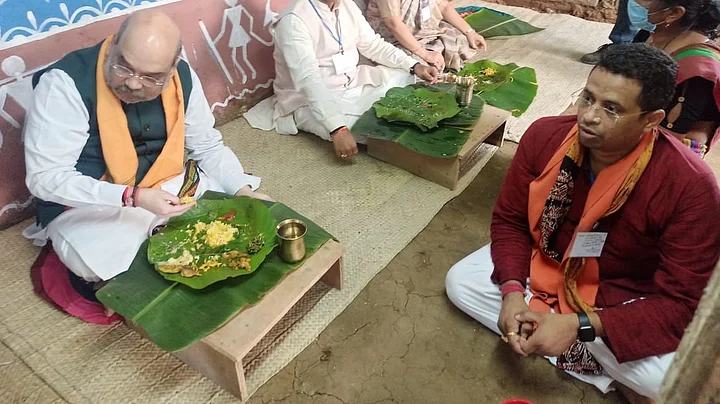With the Bihar elections done and dusted, it is now quite evidently Mission West Bengal for the BJP. Union Home Minister Amit Shah, in a two-day visit to West Bengal sounded the poll bugle saying that the “death knell had been rung for the Mamata Banerjee government”.
Mr. Shah’s visit seemed to have a single point agenda, to woo the Adivasi and scheduled caste voters. His two lunches in two days were at a Adivasi and a Matua (SC) household.
On the eve of Shah’s visit, however, West Bengal Chief Minister Mamata Banerjee announced land rights for 25,000 refugee families. She also announced a Rs 10 crore and Rs 5 crore grant from the Matua Development Board and the Namashudra Development Board respectively.
Who are The Namashudras and Matuas?
The Namashudras are a caste group that traditionally fall outside the four-tier Hindu varna system. They were earlier referred to as “Chandals”, often used as a slur in most parts of West Bengal.
The Matua movement started as a caste uprising in undivided Bengal, originating in the Faridpur district of East Bengal in the mid 19th century. It was led by Harichand Thakur, who was born to a Namashudra peasant family. He established the Matua Mahasangha, or the Matua sect of Vaishnavite Hinduism that did not adhere to the traditional varna system.
After Harichand’s death in 1878, his son Guruchand Thakur provided a boost to the movement and expanded its influence over a large section of the community. It also attracted some other Dalit groups. As a community, the Namashudras, away from the anti-partition movement in the early 20th century because they were led by upper-caste brahmins.
Both the Namashudra and the Matua community grew in the years leading up to Independence. In the Partition of that followed, West Bengal saw a large-scale influx of these social groups from East Bengal, now Bangladesh.
Since then the Matua and Namashudra communities, now estimated to have a population of around 3 crore in the state with influence in six parliamentary seats, have been an important electoral group in West Bengal, with political parties across the spectrum trying to win their vote.
In the context of the Bengal elections of 2021, the Matua community has been the centrepoint of the BJP’s pro-CAA push in the state. The Trinamool, on the other hand, which has even fielded members of the community’s main family in elections, has made an early start in ensuring that they don’t lose an important vote bank.
What Shah’s Visit Says About BJP’s Caste Strategy In Bengal
Shah began his visit with in the Bankura district of the state, which has about a 14.5 percent Scheduled Tribe population. He started by garlanding a “statue of Birsa Munda”, a tribal icon. However, it later turned out that the statue was not actually that of Birsa Munda’s and when this was pointed out, a portrait of his was placed at the foot of the statue, to which Shah paid a floral tribute. The logistical and research mess-up notwithstanding, it was clear that the tribal community was the target of this visit.
This was followed by an organizational meet and lunch at an Adivasi household in the district. It was a traditional Bengali lunch consisting of dishes like rice, roti, dal, aloo posto and five types of fried vegetables.
The schedule for the next day involved visits to the Dakshineshwar Kali Temple, a meeting with Bengali music maestro Ajoy Chakraborty and then lunch at a Matua household in Kolkata.
“In the state’s Adivasi sector like Bankura, neither has the money granted for their houses reached the people, nor have the 6,000 for farmers been granted to them. Every poor man is supposed to get 5 lakh rupees insurance, that has not reached them either”, said Shah in Bankura, pointing out that the Mamata government has blocked over 80 schemes of the central government that were meant for Dalits and adivasis.
In the 2019 elections, the Bankura constituency had gone to the BJP, where veteran TMC leader and Minister Subrata Mukherjee was beaten by over 1 lakh votes.
TMC’s Targeted SC Campaign
The Trinamool Congress, on the other hand, began a concerted campaign to reach out to Scheduled Caste voters in October.
In a campaign called “Tapashilir Sanglap” (Conversations with the Scheduled Caste), envisaged by Prashant Kishor’s Indian Political Action Committee (IPAC), the party identified 10,000 villages across 150 assembly constituencies with a sizeable SC population.
There were about 200 vans with party branding that were run around these districts. Local SC leaders who were identified would travel on these vans and spread awareness on caste-specific schemes that the Trinamool government has introduced. They would also spread awareness of how “anti-Dalit” the BJP is.
As a response to Shah’s Matua push, Banerjee announced the land rights for refugee families.
“Today, we are giving 25,000 land right documents to the refugees. A total of 1.25 lakh refugee families would be given land rights in the days to come”, said Banerjee while announcing the scheme.
"This land right document will act as proof that you (the recipients) are a citizen of this country. No one can take away your citizenship”, she said to counter the BJP’s CAA narrative.
The land deed will be without any conditions, said the Chief Minister.
But will campaigning on BJP downfalls in North India help the TMC win this crucial vote-bank? Given that the role caste plays in Bengal is diametrically different from how it plays out in North India, maybe not. However, it is clear that after a long time, caste will be a determining factor in West Bengal elections.
(At The Quint, we question everything. Play an active role in shaping our journalism by becoming a member today.)
